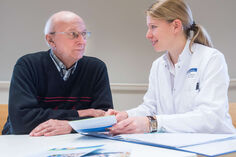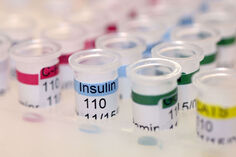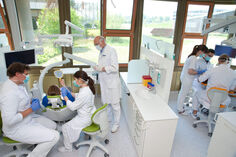Final Reports 2004
Dr. Christian Anthony M. Ermita - Manila, Philippines
The International Summerschool for Clinical Periodontology and Implantology was organized by the Section of Periodontology, Department of Operative Dentistry of the University of Heidelberg. The summerschool was composed of 20 dentists from 9 different countries, namely: Portugal, Italy, Hungary, Bosnia-Herzagovina, Italy, Greece, South Korea, Hong Kong and the Philippines. It is worthy to note that most of the participants were also young members of the faculty of dentistry from their respective universities back home. It was truly quite a unique mixture which made the summerschool even more interesting.
The program director of the summerschool was Dr. Ti-Sun Kim who was the assistant director of the Section of Periodontology. This was the third time that such a summerschool was organized by Dr. Kim. The first two was held in Yonsei University in South Korea. In one of my conversations with her she mentioned that one of the objectives of the summerschool was to provide a forum for the exchange of ideas between the participants and encourage and develop professional working relationships between the participants.
The program was divided into two weeks; the first week was devoted to Periodontology and the second week on Regenerative Therapy and Implantology. The lectures during the first week were given primarily by the faculty members of the university of Heidelberg. The course outline was given at the first day in order for the participants to know exactly what topics would be discussed for each particular day. The schedule indeed was quite full with little or no time for breaks, but this was to be expected since there was only two weeks for the summerschool.
The first series of lectures covered areas such as anatomy of the periodontium, etiology and pathogenesis of periodontal diseases as well as the new classification of periodontal diseases. These topics seem very basic but Dr. Kim clearly explained why there was such a need for it to be that way. Since the was made up of dentists coming from different parts of the world, Dr. Kim pointed out the importance of reviewing the basics in order to be sure that there would be a common understanding of all the things that will be discussed in the following days. Dr. Kim also reminded the participants that even though they may have heard similar lectures before, they could always learn something new from it. Among the lectures of the first day, the topic on anti-infective therapy could be considered as the highlight of the day. In this lecture Dr. Kim presented the treatment regimen being followed at the dental hospital, from the initial examination followed by cause related therapy (full mouth disinfection), reevaluation after 6-12 weeks up to supportive periodontal therapy. From this lecture one could very well see the treatment philosophy of the section of periodontology and how this is translated into their treatment planning and decision making. Indeed from the very start of the first day I knew that attending this summerschool was going to be worth it.
In the following day we had lectures on root debridement and diagnosis. The lecture of Dr. Dannewitz on microbiological diagnosis was entirely new to me. Dr. Dannewitz discussed the different methods of detection from culturing to immunological assays and the use of DNA probes like the IAI Pado test. During this lecture I could only wish if it would be possible to have the same kind of testing done in our university. The lecture of Dr. Eickholz on Treatment Planning was also quite new and interesting. In this lecture he started with the presentation of a Quality Criteria to describe the different possible treatment outcomes of periodontal therapy. He also presented ways of determining the prognosis at the patient level, tooth level down to the site level of a particular tooth. He explained that this was very important in developing a specific treatment plan for any patient. The three-part lecture of Dr. Kim on the role Antibiotics in Periodontology highlighted the use of antibiotics for prophylaxis; especially against endocarditis; as well as their use as adjuncts in the treatment of periodontal disease. In this lecture Dr. Kim shared her experiences in handling medically compromised patients in the dental hospital and she also stressed the importance of being aware of any medical condition that patients may have in order to avoid complications. Another long but very interesting lecture was the one given by Prof Machtei on Periodontal Medicine. Prof. Machtei explained the Bi-directional Oral-Systemic Interaction; how periodontal disease act as a risk factor for systemic conditions how systemic conditions affect the periodontium.
There were many other concepts that were discussed by other lecturers, like full mouth disinfection, GTR vs. GBR, meta-analysis, supportive therapy and subtraction radiography; which were also very helpful and informative. But almost all the lecturers had one thing in common, they were very evidence based. They would be very careful in answering the participants questions, defining a particular answer as a personal opinion from what is based on current scientific evidence, citing the latest and important researches relevant to the topic at hand. I was also very happy to discover that what we were taught in our own university was not very different from the philosophy or school of thought at Heidelberg. Although we do not follow the principle of full mouth disinfection in our university we nevertheless try to utilize a conservative approach to treatment and this has reinforced or validated all the concepts that I hold as true in periodontology.
During the second week of the program we were able to listen to several lecturers from other universities as well who cooperated in the summerschool. There was Prof. Ernest Hausmann from New York State University at Buffalo, USA; Prof. Machtei from Ramban Medical Center in Israel; and several other professors from other Universities around Germany, like Dr. Paul Weigel from the University of Frankfurt and Dr. Jorg Neugebauer from the University of Cologne. The inclusion of these guest lecturers provided valuable inputs and introduced other treatment concepts that was not typical to what was being done at the University of Heidelberg. These differences in opinions resulted to even livelier discussions and in my opinion contributed to the over all success of the summerschool.
Aside from the lectures, we also performed hands-on exercises in the laboratory. These included exercises on Periodontal flap surgery, Resective therapy and Tunnel preparations, as well as Regenerative periodontal surgery, all done on pigs jaws. The laboratory was well equipped especially for demonstrations. A camera connected to two big tv monitors provided an excellent view of the procedures being demonstrated. The units as well as all the instruments used in the laboratory sessions were complete and properly sterilized. The hands-on course in implantology was conducted at the Dentsply-Friadent headquarters in Mannheim. During this practical course, the participants were again divided into pairs and assigned to a cubicle complete with all the kits, implant engine and mannequins. The new XIVE implant system as well as the ANKYLOS implant system were used for the course. At the end of the day all the participants were given CD-ROMs and manuals on the two implant systems as well as certificates for attending the course.
We were also given the opportunity to handle actual patients who are currently under periodontal supportive therapy at the University of Heidelberg. There were around 10 patients, and we worked on them by pairs. I worked with Dr. Chang-Kyu Lee, an implantologist from South Korea. I performed the periodontal examination of the patient (checking BOP, plaque index, and pocket probing depth measurements) while Dr. Lee took down the measurements on the patients chart. After having identified the specific problem sites/teeth, we were the instructed to proceed with scaling and polishing as well as root planning of the identified periodontal pockets. (>3 mm and +BOP). Dr. Lee did the initial scaling and polishing after which I performed the root planing. This exercise gave us the opportunity to review the conditions of these patients, the diagnosis and treatment that they have received and see the different records and x-rays in their respective charts. While there was supposed to have been a time allotted for the review and discussion of these cases, some problems with the schedule of the day prevented such an extensive discussion which I thought was very unfortunate for us. This was one portion of the course where I really wished we could have to spent more time.
Aside from the scientific part of the summer school, we were also given lectures on German culture and German history. These lectures were considered a welcome break from the series of scientific lectures that filled the rest of the day and it also helped the participants relax and rest their tired brains from information overload.
Another unique aspect of the program was the organized excursions. There were two scheduled excursions, the first one was to Stuttgart where they brought us to the Benz Museum followed by a trip to Ludwigsburg were we were a given a guided tour of the castle. The second was a trip to Bensheim were we visited the Sirona Dental Company, where they showed us their latest products like the C1+ treatment center, the most expensive dental chair in the market, and the new Cerac 3 which uses CAD-Cam technology for the instant chairside fabrication of porcelain restorations. Then we were treated to a very special dinner at The English garden also in Bensheim. I would like to say that these planned excursions were very beneficial in that it provided the participants time not only to relax but also to enjoy each others company.
The summerschool was truly a great experience, for not only did I get the chance to study in a very distinguished university but I also was able to make new friends from all over the world. In the two weeks I spent in Heidelberg I have learned to love the place not only it’s natural beauty but also for the people that made our stay memorable. I’m looking forward to coming back again, soon
Acknowledgements
* I would also like to thank the following persons for making this summerschool possible:
- To the NAGP for providing me with the scholarship to attend this summerschool.
- To Dr. Nanette Vergel De Dios – my mentor in periodontology
- Dean Elizabeth De Castro – for all the encouragement
- The companies that supported the summerschool, GABA, Dentsply-Friadent, Sirona and Gore & Ivoclar-Vivadent
- To all our professors and lecturers of the summerschool; Prof. Ernest Hausmann and Prof. Machtei
- To the office and clinical staff of the Section of Periodontology; Dr. Bettina Dannewitz, Dr. Christian Obst, Dr. Diana Krigar,
- Dr. Peter Eickholz; looking forward to our next football game professor
- To ALL MY CLASSMATES : Orlando, Tina, Nedzad, Sanja, Dr, Jin, Gloria, Dr. Lee, Mateo, Federico, Andrea & Dr. Chan , I miss you guys!
- And most of all to Dr. Ti-Sun Kim who organized this summerschool, thank you very much for all your efforts to make our stay fruitful and enjoyable. I’m looking forward to seeing you again soon.


